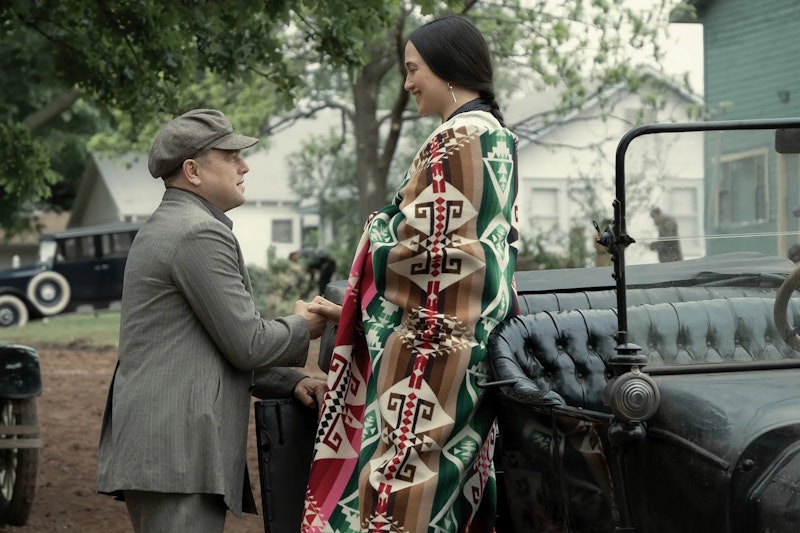It's stunning how shaky Martin Scorsese’s confidence is with Killers of the Flower Moon. It’s possible that when he first set out to adapt David Grann’s book about the systematic murders of the Osage to loot them for their newfound oil money, Scorsese had a clear picture in his head about the kind of historic epic he was making—one slowly unfolding as the newly-formed Bureau of Investigation puts the pieces together of the dark reality bubbly to the surface of a booming town. It could’ve been Scorsese’s Bad Day at Black Rock, John Sturges’ neo-Western masterpiece where that man of American moral goodness Spencer Tracey rolls into town to uncover a racist conspiracy so ingrained in the town’s fabric that not a single person in the valley is innocent.
The rewrites to Killers were extensive after Scorsese spent time on the ground in Oklahoma and consulted with the Osage people about the script. The perspective was flawed: an outdated white savior coming in and solving the murders, which just by the form of the story would imply a certain triumph or satisfaction in figuring out the mystery. But there never was a mystery to begin with, the facts were always clear. Everyone knew who the murderers were, everyone knew the greedy forces behind it; the deception was only in trying to obfuscate what was going on right before everyone’s eyes. So Scorsese changed characters for his favorite leading man of the 21st century, Leonardo DiCaprio, from the G-man Tom White (now played brilliantly by Jesse Plemons) to Ernest Burkhart, one of the most disconcerting protagonists in his entire oeuvre.
Instead of digging up the past, the film runs vaguely straight, with Ernest returning from the Great War to Oklahoma, calling upon his uncle William “King” Hale (Robert DeNiro, in his most terrifying and lively performance since Cape Fear) for work. Hale’s as much a classical cattle patriarch (a character type that death rattled in post-war Hollywood with the likes of John Wayne in Red River and Walter Huston in The Furies) as he is a mid-level Scorsese crime boss, a man growing his cruel gambit held up by very basic forces of personal power that ultimately gets in over his head in scale. Ernest is the useful idiot for Hale, an impressionable young man who’s not all there that he can send to marry into the Osage in order to have their wealth willed away to the whites. While driving cabs downtown he gets the eye for Molly, the true heart of the film whose quiet warmth and muted paranoia is brought to the screen by another best-of-the-decade performance by Lily Gladstone.
Molly and Ernest’s romance is strangely genuine, given the fact that Ernest is actively working with his uncle to murder her entire family. It’s an eerie truth, one which, if it wasn’t true, could never be believable in fiction. The reframing of perspective from the forensic past-tense into an ostensibly straightforward narrative actually makes the narrative murkier. How could Ernest apparently love his wife and be killing her for money? Scorsese doesn’t seem to know, and I don’t mean that as bad—he has all the facts, but knows they’re deceptive of the truth. The three-and-a half-hours of its runtime are spent bouncing back and forth between compartmentalizations: on one side is the greedy and detached Ernest, and on the other is human man with desire for connection and community. The two can’t be reconciled, and the horrific pursuit of one leads to the complete destruction of the other. The police investigation, which in the realized version of the film doesn’t even start until at least halfway into its massive runtime (like a whole feature following another, or an old-school directional shift after an intermission), is less an unearthing than a confrontation with the impossibility of the mindset Ernest has put himself in.
Killers of the Flower Moon feels at once a film fully of this time and yet out of the past. It is not 2023’s only auteur-driven film structured on compartmentalizing atrocity and humanity (Oppenheimer) or about a whole town covering up a marital conspiracy (Ferrari), and it’s also fitting that Gladstone’s next great performance comes the same year that the director of her breakout, Kelly Reichardt, made the best American film of the year. Still, Killers’ uneasy formality is something more out of the primordial swamps of New Hollywood rather than its late-1970s United Artists’ precision. I could say that if The Irishman is the apotheosis of Scorsese’s career, then Killers of the Flower Moon is a wholly new step, but that would be deceptive. Scorsese’s in uncharted waters, but his broken confidence while wrestling with an insurmountable question of perspective is stylistically more like the ambiguity that he and his colleagues were trying to achieve in the late-1960s and not as much the precision of Heaven’s Gate.
Navigating through clear facts towards a murky truth, Scorsese seems to conclude, is ultimately impossible, if not outright foolish, yet the examination is still important. He doesn’t have the answers, and that’s good—those that decry it as editorial are merely ousting themselves as not being able to reconcile with the truth, like many at the center of the film itself. Some point to Killers of the Flower Moon as a definitive thesis by Scorsese, although it’s anything but: the case is closed, but what it all means and the conversation about its grander implications are yet to be had, and need to be had.

